新概念英语第二册分词课件(共38张PPT)
文档属性
| 名称 | 新概念英语第二册分词课件(共38张PPT) | 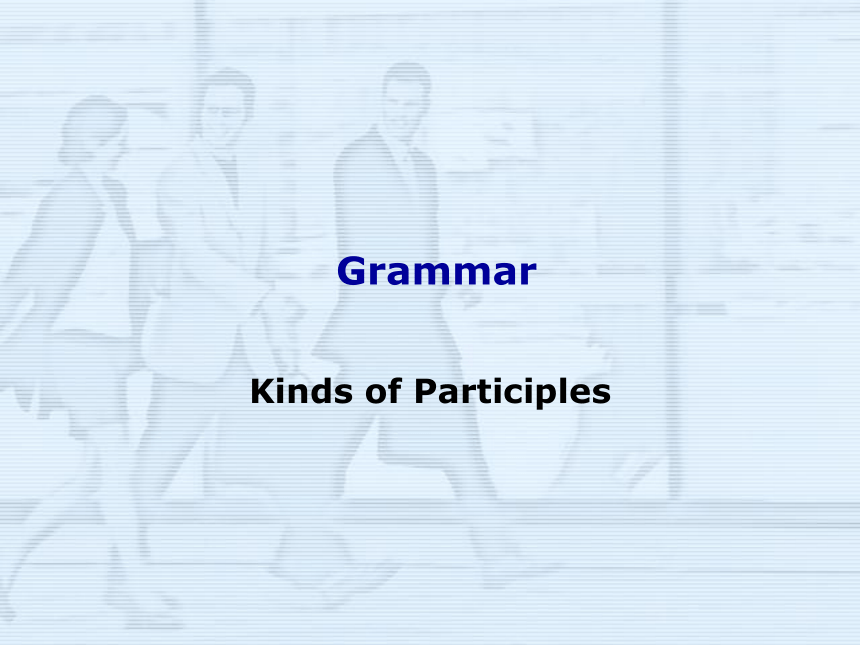 | |
| 格式 | ppt | ||
| 文件大小 | 460.5KB | ||
| 资源类型 | 教案 | ||
| 版本资源 | 新概念英语 | ||
| 科目 | 英语 | ||
| 更新时间 | 2023-06-21 21:20:54 | ||
图片预览

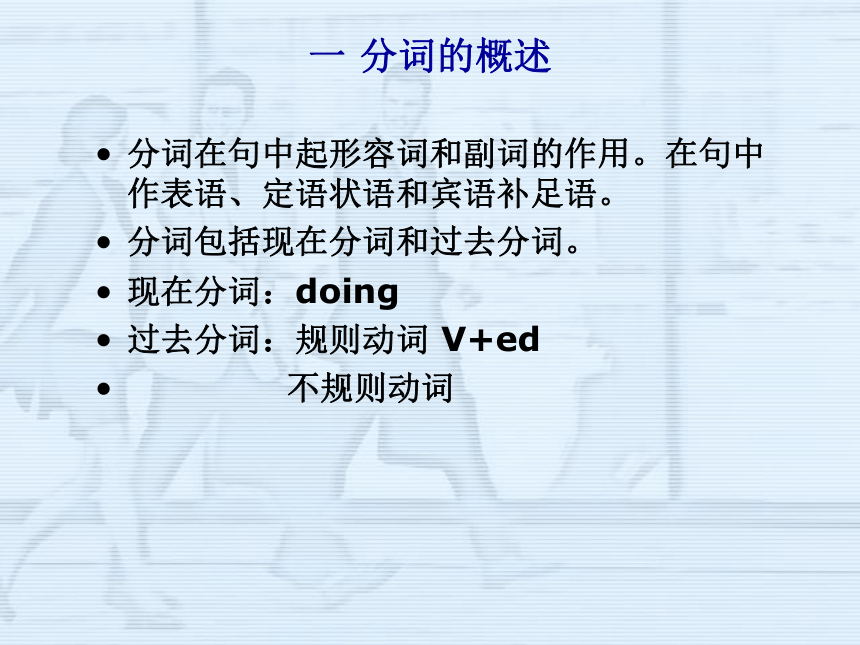
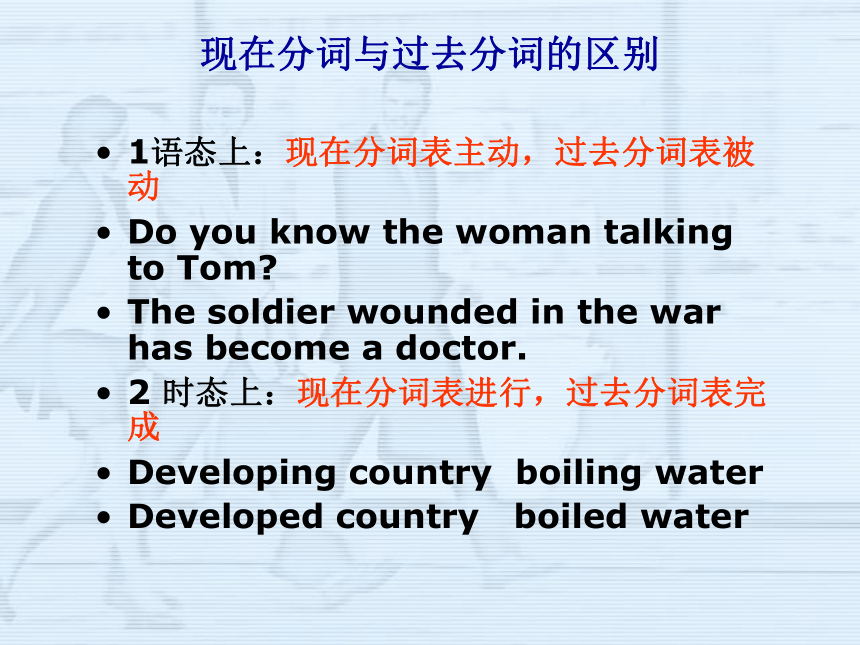

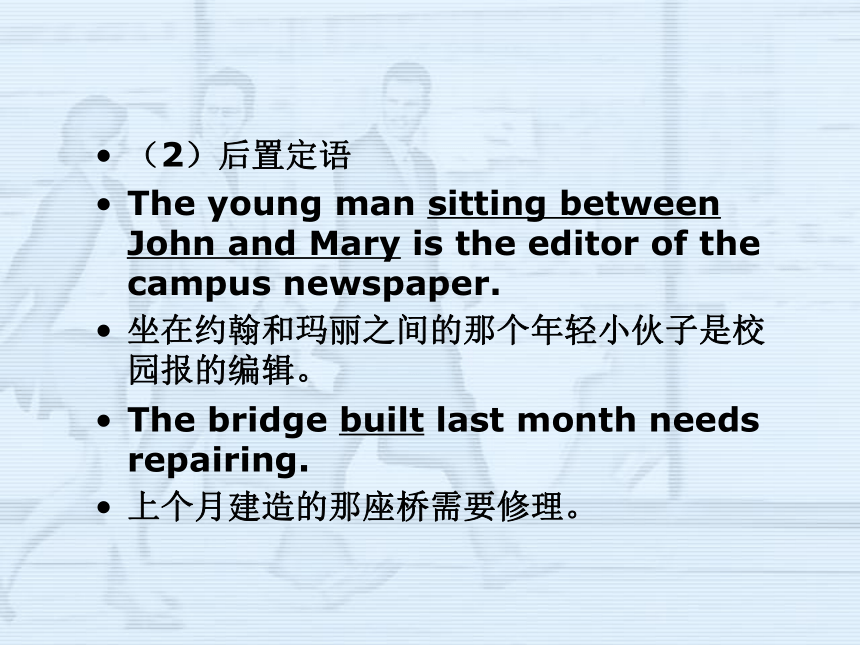
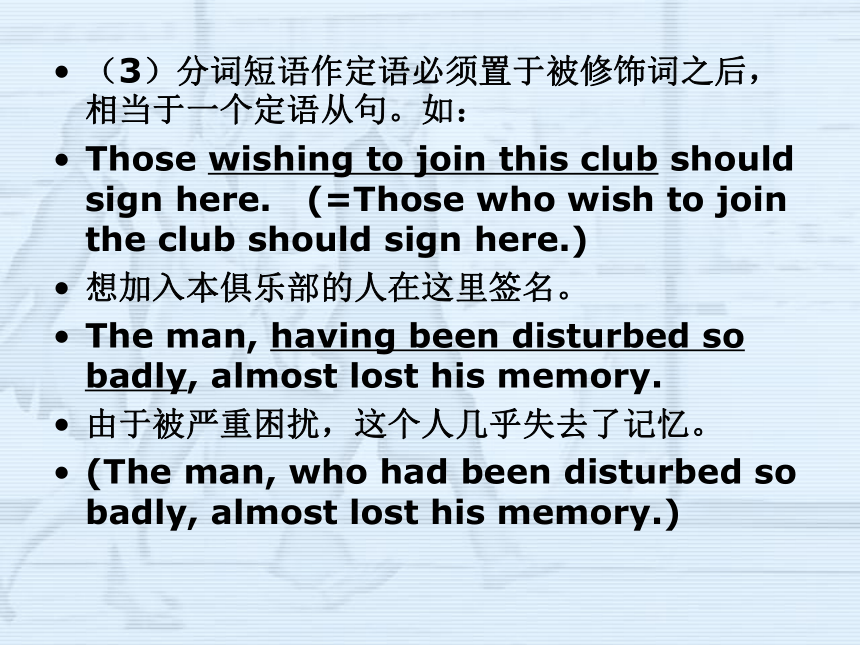
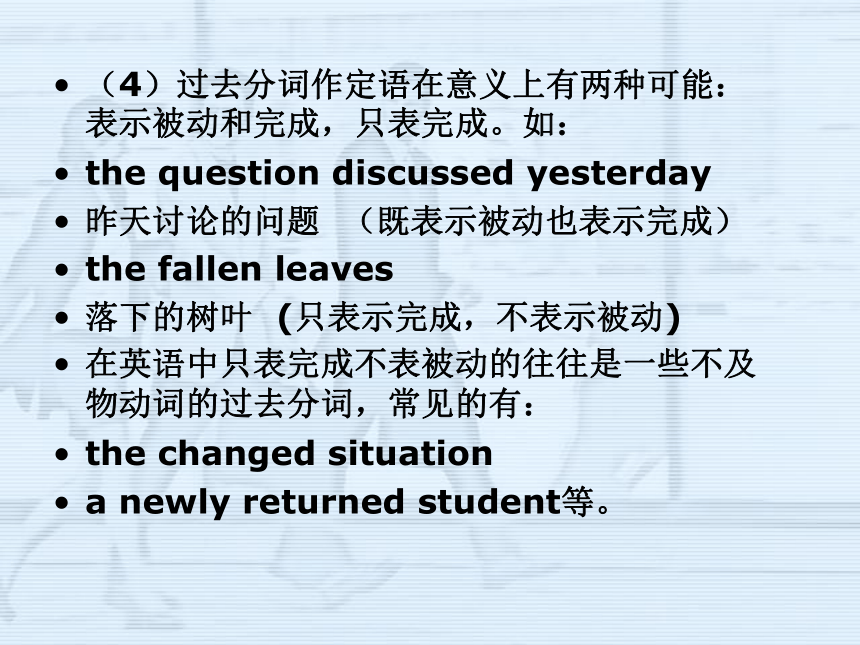
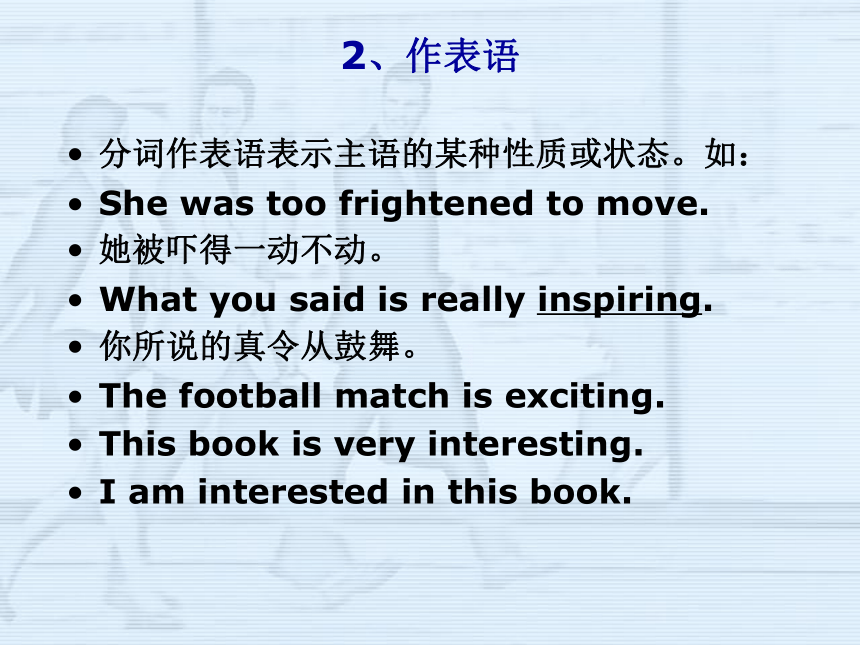


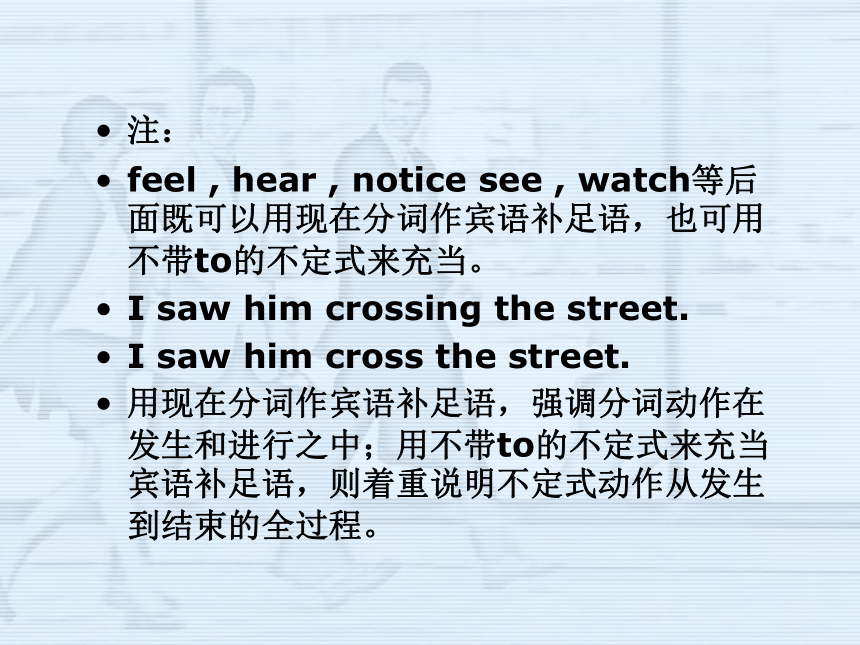
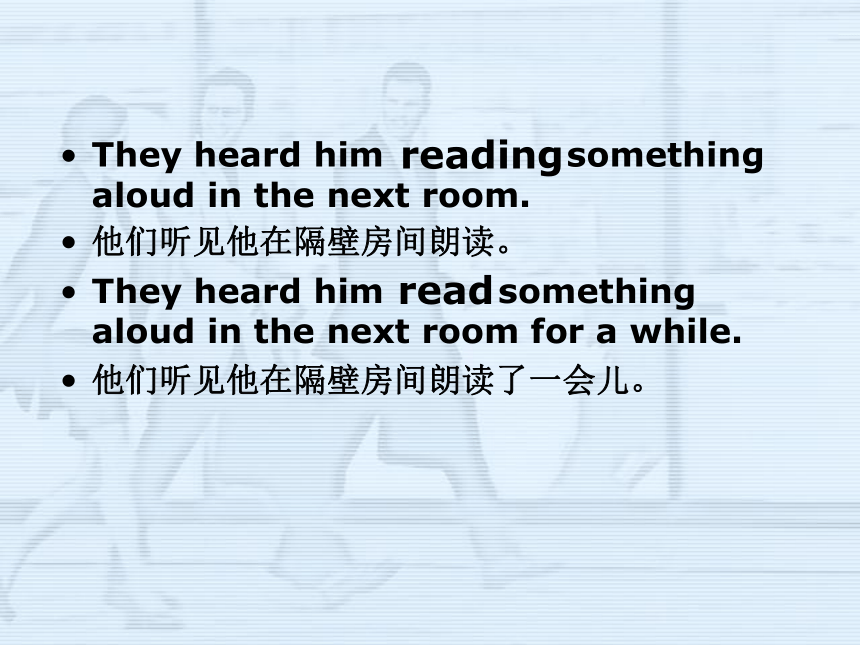
文档简介
(共38张PPT)
Grammar
Kinds of Participles
一 分词的概述
分词在句中起形容词和副词的作用。在句中作表语、定语状语和宾语补足语。
分词包括现在分词和过去分词。
现在分词:doing
过去分词:规则动词 V+ed
不规则动词
现在分词与过去分词的区别
1语态上:现在分词表主动,过去分词表被动
Do you know the woman talking to Tom
The soldier wounded in the war has become a doctor.
2 时态上:现在分词表进行,过去分词表完成
Developing country boiling water
Developed country boiled water
二、分词的作用
1、作定语
分词作定语有两种形式。它可以放在被修饰的名词之前,称为前置定语。有的放在被修饰的名词之后,称为后置定语。
(1)前置定语
He is a promising young man. 他是一个有前途的年轻人。
Make less noise. There’s a sleeping child. 不要出太大声音,有个孩子在睡觉。
We only sell used books. 我们只卖用过的书。
(2)后置定语
The young man sitting between John and Mary is the editor of the campus newspaper.
坐在约翰和玛丽之间的那个年轻小伙子是校园报的编辑。
The bridge built last month needs repairing.
上个月建造的那座桥需要修理。
(3)分词短语作定语必须置于被修饰词之后,相当于一个定语从句。如:
Those wishing to join this club should sign here. (=Those who wish to join the club should sign here.)
想加入本俱乐部的人在这里签名。
The man, having been disturbed so badly, almost lost his memory.
由于被严重困扰,这个人几乎失去了记忆。
(The man, who had been disturbed so badly, almost lost his memory.)
(4)过去分词作定语在意义上有两种可能:表示被动和完成,只表完成。如:
the question discussed yesterday
昨天讨论的问题 (既表示被动也表示完成)
the fallen leaves
落下的树叶 (只表示完成,不表示被动)
在英语中只表完成不表被动的往往是一些不及物动词的过去分词,常见的有:
the changed situation
a newly returned student等。
2、作表语
分词作表语表示主语的某种性质或状态。如:
She was too frightened to move.
她被吓得一动不动。
What you said is really inspiring.
你所说的真令从鼓舞。
The football match is exciting.
This book is very interesting.
I am interested in this book.
3、作宾语补足语
可以跟宾语补足语的谓语动词有 see, watch, hear, set, keep, find, have, get 等词。
I saw him walking in the street.
我看见他在街上走。
I heard them singing in the classroom.
我听见他们在教室里唱歌。
We found the boy sleeping.
我们发现小孩睡着了。
A)I heard my brother ( singing , sung ) in the next room
B)I heard the song ( singing , sung ) in English .
注:
feel , hear , notice see , watch等后面既可以用现在分词作宾语补足语,也可用不带to的不定式来充当。
I saw him crossing the street.
I saw him cross the street.
用现在分词作宾语补足语,强调分词动作在发生和进行之中;用不带to的不定式来充当宾语补足语,则着重说明不定式动作从发生到结束的全过程。
They heard him something aloud in the next room.
他们听见他在隔壁房间朗读。
They heard him something aloud in the next room for a while.
他们听见他在隔壁房间朗读了一会儿。
read
reading
过去分词与宾语之间是被动的关系。
1. I heard my name called
我听见有人在叫我的名字。
2 .I found the egg eaten by a snake.
3. I can’t make myself understood because of my broken English.
我不能用英语表达我的意思,因为我糟糕的英语
have 后面的宾语补足语用过去分词常表示动作不是句子的主语发出的,而是由别人做的。
I have my hair cut. 我理发了。(是别人给我理发)
She has her bike repaired.
她把自行车修理了。(别人修理的)
They have their house rebuilt.
他们重修了房子。
现在分词与过去分词在作状语的区别
现在分词表主动进行,过去分词表被动完成
1. Seeing from the top of the tower, we can see a beautiful factory.
Seen from the top of the tower, the factory looks beautiful.
2. Hearing the bad news, they couldn’t help crying.
3. Given more time, we could do it better.
4. They came into the classroom, singing and laughing.
5. The teacher stood there, surrounded by many students.
4、作状语
(1)表示时间
Arriving in Paris, I lost my way. 到了巴黎,我迷了路。
The hunter walked slowly in the forest, followed by his wolf-dog. 猎人在森林里慢慢地走着,后面跟着一只狼狗。
表示与主句中谓语动词同时性的现在分词强调时间意义时,分词前可以加上while, when等从属连接词,但as没有这种用法。如:
Don’t talk while having dinner.
吃饭时不要说话。
When crossing the street, do be careful. 过马路时要小心。
(2)表示原因
表示原因的分词短语一般置于句首。
Having lived in London for years, I almost know every place quite well. 在伦敦住过多年,我几乎对每个地方都很熟悉。
Seriously injured, he had to be taken to hospital. 由于伤得严重,只好把他送往医院。
(3)表示结果
The fire lasted nearly a month, leaving nothing valuable. 大火持续了近一个月,几乎没剩下什么有用的东西。
Football is played in more than 80 countries, making it a popular sport. 80多个国家都踢足球,因此足球成了一种很流行的运动。
(4)表示方式
I stood by the door, not daring to say a word.
我站在门旁,不敢说一句话。
(5)表示条件
United, we stand; divided, we fall. 联合起来我们就能站立,分裂我们必然倒下。
Being more careful, you can make fewer mistakes. 如果你更细心,你会犯更少的错误。
强调条件时,可以在前面加上unless, once等。如:
You shouldn’t come in unless asked to. 不让你进来你不准进来。
Once losing this chance, you can’t easily find it. 一旦失去这次机会你就很难找回。
现在分词的被动式和完成式
被动式: being done 表示一个现在进行的完成动作。
1.The building being repaired is our library.
2.The question being discussed is very important.
3. As we approached the village, we saw new houses being put up.
完成式:having done 所表示的动作在谓语动词所表示的动作之前发生。
1. Having been to the Great Wall many times, he didn’t go there last week.
2. Having turned off the radio, he began to go over his lessons.
3. Not having received his father’s letter, he decided to make a call to him.
二、分词的独立主格结构
分词短语作状语时,其逻辑主语就是句子的主语,否则,就必须在分词前另加上自己的逻辑主语(名词或主格代词)的这个结构叫独立主格结构或分词的复合结构。
1、独立主格结构常放在句首。表示时间、条件、原因时,其作用分别相当于个时间、条件、原因状语从名句。表示伴随方式时,相当于一个并列句。如:
Supper finished (=After supper was finished), we started to discuss the picnic.
吃完晚饭,我们开始讨论野餐的事。
All the tickets having been sold out (=As all the tickets having been sold out), we had to wait for the next week’s show.
所有的票都卖出去了,我们只好等着看下周的演出。
2、表示独立主格结构中的being常省略。如:
The football match (being) over, crowds of people poured out into the steet.
足球赛五结束,从群便涌到大街上。
Nobody (being) in, I didn’t enter the hall.
里面没有人,我没进大厅。
3、表示伴随方式的独立主格结构,有时可用“with+宾语+宾语补足语”的结构来替换。如:
He lay there thinking, his hands behind his head (with his hands behind his head).
他双手放在头下,躺在那里思考着。
The river looks more beautiful, flowers and grass growing on both sides(=with flowers and grass growing on both sides).
这条河看上去更加漂亮,因为两岸长满了鲜花和绿草。
with+宾语+宾语补足语的结构是英语中常见常用的结构,其宾语补足语可以是现在分词、过去分词、不定式、形容词、副词、介词短语等,在句中可作定语,也可作状语,表示原因、方式等。如:
The children looked at us, with their eyes opening wide.
孩子们眼睛睁得大大地看着我。
I would miss the train, with no one to wake me up.
没人叫我,我会错过火车的。
The river with grass and flowers on both sides runs through our schoolyard.
这条两河两岸长满鲜花和绿草正从我们校园穿过。
With the examinations over, we had a long time to rest.
考试结束了,我们有一段长长的时间可以休息。
4、有些惯用的分词短语在句里可以没有逻辑上的主语而独立存在,它们往往作为句子的独立成分来修饰全句。如:
generally/strictly/roughly/broadly/narrowly speaking, judging from/by, considering, supposing, providing, provided等。如:
Talking of the computer, I like it very much.
谈到电脑,我非常喜欢。
Considering the time, we have decided to start early tomorrow morning.
考试到时间,我们已经决定明早一早出发。
Grammar
Kinds of Participles
一 分词的概述
分词在句中起形容词和副词的作用。在句中作表语、定语状语和宾语补足语。
分词包括现在分词和过去分词。
现在分词:doing
过去分词:规则动词 V+ed
不规则动词
现在分词与过去分词的区别
1语态上:现在分词表主动,过去分词表被动
Do you know the woman talking to Tom
The soldier wounded in the war has become a doctor.
2 时态上:现在分词表进行,过去分词表完成
Developing country boiling water
Developed country boiled water
二、分词的作用
1、作定语
分词作定语有两种形式。它可以放在被修饰的名词之前,称为前置定语。有的放在被修饰的名词之后,称为后置定语。
(1)前置定语
He is a promising young man. 他是一个有前途的年轻人。
Make less noise. There’s a sleeping child. 不要出太大声音,有个孩子在睡觉。
We only sell used books. 我们只卖用过的书。
(2)后置定语
The young man sitting between John and Mary is the editor of the campus newspaper.
坐在约翰和玛丽之间的那个年轻小伙子是校园报的编辑。
The bridge built last month needs repairing.
上个月建造的那座桥需要修理。
(3)分词短语作定语必须置于被修饰词之后,相当于一个定语从句。如:
Those wishing to join this club should sign here. (=Those who wish to join the club should sign here.)
想加入本俱乐部的人在这里签名。
The man, having been disturbed so badly, almost lost his memory.
由于被严重困扰,这个人几乎失去了记忆。
(The man, who had been disturbed so badly, almost lost his memory.)
(4)过去分词作定语在意义上有两种可能:表示被动和完成,只表完成。如:
the question discussed yesterday
昨天讨论的问题 (既表示被动也表示完成)
the fallen leaves
落下的树叶 (只表示完成,不表示被动)
在英语中只表完成不表被动的往往是一些不及物动词的过去分词,常见的有:
the changed situation
a newly returned student等。
2、作表语
分词作表语表示主语的某种性质或状态。如:
She was too frightened to move.
她被吓得一动不动。
What you said is really inspiring.
你所说的真令从鼓舞。
The football match is exciting.
This book is very interesting.
I am interested in this book.
3、作宾语补足语
可以跟宾语补足语的谓语动词有 see, watch, hear, set, keep, find, have, get 等词。
I saw him walking in the street.
我看见他在街上走。
I heard them singing in the classroom.
我听见他们在教室里唱歌。
We found the boy sleeping.
我们发现小孩睡着了。
A)I heard my brother ( singing , sung ) in the next room
B)I heard the song ( singing , sung ) in English .
注:
feel , hear , notice see , watch等后面既可以用现在分词作宾语补足语,也可用不带to的不定式来充当。
I saw him crossing the street.
I saw him cross the street.
用现在分词作宾语补足语,强调分词动作在发生和进行之中;用不带to的不定式来充当宾语补足语,则着重说明不定式动作从发生到结束的全过程。
They heard him something aloud in the next room.
他们听见他在隔壁房间朗读。
They heard him something aloud in the next room for a while.
他们听见他在隔壁房间朗读了一会儿。
read
reading
过去分词与宾语之间是被动的关系。
1. I heard my name called
我听见有人在叫我的名字。
2 .I found the egg eaten by a snake.
3. I can’t make myself understood because of my broken English.
我不能用英语表达我的意思,因为我糟糕的英语
have 后面的宾语补足语用过去分词常表示动作不是句子的主语发出的,而是由别人做的。
I have my hair cut. 我理发了。(是别人给我理发)
She has her bike repaired.
她把自行车修理了。(别人修理的)
They have their house rebuilt.
他们重修了房子。
现在分词与过去分词在作状语的区别
现在分词表主动进行,过去分词表被动完成
1. Seeing from the top of the tower, we can see a beautiful factory.
Seen from the top of the tower, the factory looks beautiful.
2. Hearing the bad news, they couldn’t help crying.
3. Given more time, we could do it better.
4. They came into the classroom, singing and laughing.
5. The teacher stood there, surrounded by many students.
4、作状语
(1)表示时间
Arriving in Paris, I lost my way. 到了巴黎,我迷了路。
The hunter walked slowly in the forest, followed by his wolf-dog. 猎人在森林里慢慢地走着,后面跟着一只狼狗。
表示与主句中谓语动词同时性的现在分词强调时间意义时,分词前可以加上while, when等从属连接词,但as没有这种用法。如:
Don’t talk while having dinner.
吃饭时不要说话。
When crossing the street, do be careful. 过马路时要小心。
(2)表示原因
表示原因的分词短语一般置于句首。
Having lived in London for years, I almost know every place quite well. 在伦敦住过多年,我几乎对每个地方都很熟悉。
Seriously injured, he had to be taken to hospital. 由于伤得严重,只好把他送往医院。
(3)表示结果
The fire lasted nearly a month, leaving nothing valuable. 大火持续了近一个月,几乎没剩下什么有用的东西。
Football is played in more than 80 countries, making it a popular sport. 80多个国家都踢足球,因此足球成了一种很流行的运动。
(4)表示方式
I stood by the door, not daring to say a word.
我站在门旁,不敢说一句话。
(5)表示条件
United, we stand; divided, we fall. 联合起来我们就能站立,分裂我们必然倒下。
Being more careful, you can make fewer mistakes. 如果你更细心,你会犯更少的错误。
强调条件时,可以在前面加上unless, once等。如:
You shouldn’t come in unless asked to. 不让你进来你不准进来。
Once losing this chance, you can’t easily find it. 一旦失去这次机会你就很难找回。
现在分词的被动式和完成式
被动式: being done 表示一个现在进行的完成动作。
1.The building being repaired is our library.
2.The question being discussed is very important.
3. As we approached the village, we saw new houses being put up.
完成式:having done 所表示的动作在谓语动词所表示的动作之前发生。
1. Having been to the Great Wall many times, he didn’t go there last week.
2. Having turned off the radio, he began to go over his lessons.
3. Not having received his father’s letter, he decided to make a call to him.
二、分词的独立主格结构
分词短语作状语时,其逻辑主语就是句子的主语,否则,就必须在分词前另加上自己的逻辑主语(名词或主格代词)的这个结构叫独立主格结构或分词的复合结构。
1、独立主格结构常放在句首。表示时间、条件、原因时,其作用分别相当于个时间、条件、原因状语从名句。表示伴随方式时,相当于一个并列句。如:
Supper finished (=After supper was finished), we started to discuss the picnic.
吃完晚饭,我们开始讨论野餐的事。
All the tickets having been sold out (=As all the tickets having been sold out), we had to wait for the next week’s show.
所有的票都卖出去了,我们只好等着看下周的演出。
2、表示独立主格结构中的being常省略。如:
The football match (being) over, crowds of people poured out into the steet.
足球赛五结束,从群便涌到大街上。
Nobody (being) in, I didn’t enter the hall.
里面没有人,我没进大厅。
3、表示伴随方式的独立主格结构,有时可用“with+宾语+宾语补足语”的结构来替换。如:
He lay there thinking, his hands behind his head (with his hands behind his head).
他双手放在头下,躺在那里思考着。
The river looks more beautiful, flowers and grass growing on both sides(=with flowers and grass growing on both sides).
这条河看上去更加漂亮,因为两岸长满了鲜花和绿草。
with+宾语+宾语补足语的结构是英语中常见常用的结构,其宾语补足语可以是现在分词、过去分词、不定式、形容词、副词、介词短语等,在句中可作定语,也可作状语,表示原因、方式等。如:
The children looked at us, with their eyes opening wide.
孩子们眼睛睁得大大地看着我。
I would miss the train, with no one to wake me up.
没人叫我,我会错过火车的。
The river with grass and flowers on both sides runs through our schoolyard.
这条两河两岸长满鲜花和绿草正从我们校园穿过。
With the examinations over, we had a long time to rest.
考试结束了,我们有一段长长的时间可以休息。
4、有些惯用的分词短语在句里可以没有逻辑上的主语而独立存在,它们往往作为句子的独立成分来修饰全句。如:
generally/strictly/roughly/broadly/narrowly speaking, judging from/by, considering, supposing, providing, provided等。如:
Talking of the computer, I like it very much.
谈到电脑,我非常喜欢。
Considering the time, we have decided to start early tomorrow morning.
考试到时间,我们已经决定明早一早出发。
同课章节目录
